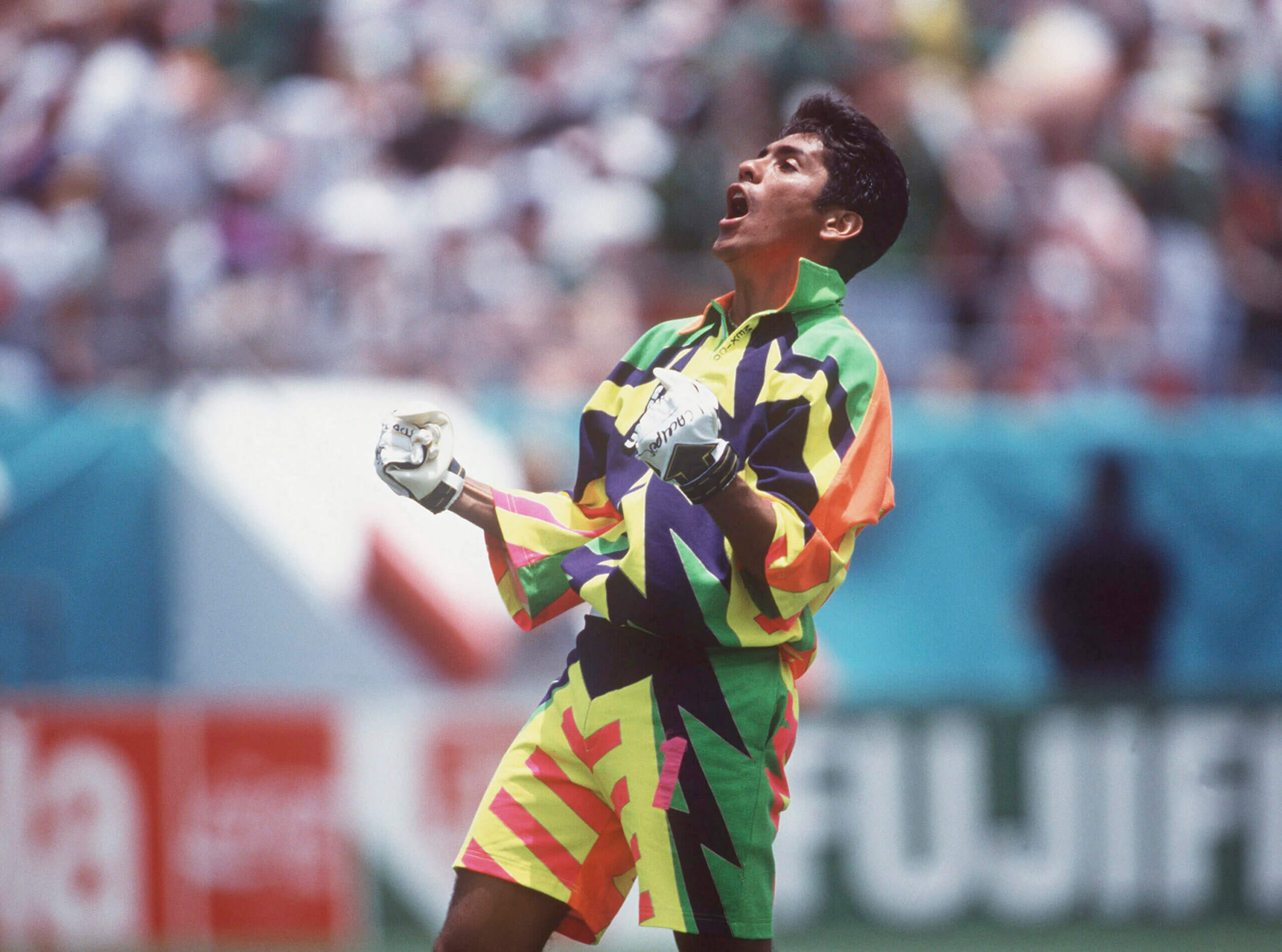Goalkeeping in South America has always been an art form. The most memorable figures are fondly known for their nicknames, like ‘The Madman’, ‘The Cat’ or ‘The Bulldog’. And for decades, the Copa America has been a showcase tournament for the continent’s boldest goalkeeping personalities.
Not every country in South America is known for producing eccentric goalkeepers. Nations like Uruguay, Ecuador, Venezuela and Chile have traditionally produced keepers who may not have stood out for their flair or sense of adventure.
Other countries, however, are home to some of the game’s trailblazers.
Argentina
The current world champions and holders of the Copa America have one of the most polarizing goalkeepers on the planet in Emiliano Martinez.
Nicknamed ‘El Dibu’, the brash Martinez has become a shot-stopping force and penalty shootout hero for the Albiceleste.
Past Argentina goalkeepers have been credited with revolutionizing the position and the late Amadeo Carrizo is considered the first sweeper-keeper. Carrizo played over 600 matches for River Plate before he retired in 1970. Carrizo later inspired former Boca Juniors goalkeeper Hugo Gatti to play with a similar style. Gatti’s long hair and headband, as well as his penchant for leaving his penalty area with the ball at his feet, earned him the nickname ‘El Loco’ or ‘Madman’.
Gatti featured for Argentina at the 1975 Copa America. Later, Nery Pumpido, a hardman of a goalkeeper, featured for Argentina at the 1983 and 1989 Copa America tournaments. Pumpido was Argentina’s starting goalkeeper in 1986 when they won their second World Cup. Four years later, he broke his leg in Argentina’s second group-stage match against the Soviet Union at the 1990 World Cup. That injury opened the door for Sergio Goycochea, whose heroics during penalty-shootout wins over Yugoslavia and Italy earned him hero status back home.
Nery Pumpido celebrates the moment Argentina won the 1986 World Cup final over West Germany in Mexico (S&G/PA Images via Getty Images)
Goycochea became a stalwart for Argentina, winning the 1991 and 1993 Copa America titles. Today, Goycochea remains relevant in his home country as a polished television football analyst and motivational speaker. Martinez will hope to follow in the footsteps of ‘Goyco’ and win his second consecutive Copa America trophy.
Brazil
Up until recently, when you thought about Brazilian footballers, goalkeepers weren’t the first players to come to mind.
Currently, two of the world’s best goalkeepers are Brazilian, with Liverpool’s Alisson and Ederson of Manchester City earning that distinction with elite play at the highest level. Seeing two Brazilian goalkeepers in the Premier League was unfathomable a decade ago.
Alisson and Ederson (incidentally, his former Manchester City team-mate Claudio Bravo became the oldest player to feature at the Copa America when he played in his country’s draw with Peru last weekend) won the 2019 Copa America with Brazil.
Before them, former Inter Milan great Julio Cesar did the same in 2004, leading the Selecao to a penalty shootout win over nemesis Argentina. Brazil has always produced quality goalkeepers but, before 2000, the country’s best shot-stoppers tended to stay in South America to play with the country’s top clubs.
Sao Paulo goalkeepers Zetti and Rogerio Ceni come to mind. Zetti was an acrobatic and sure-handed goalkeeper (who always wore dark goalkeeper pants), while Ceni became known as a battle-tested leader as well as a set-piece specialist who managed to score 131 times in his career. Ceni and the legendary Dida earned World Cup winners’ medals in 2002. Dida is, of course, an AC Milan hero. He was a towering goalkeeper who, at the 1999 Copa America, became Brazil’s first Black No 1 since 1950.


Dida (second from left), pictured with Brazil contemporaries Kaka, Cafu and Serginho (Franck Fife/AFP via Getty Images)
Current Liverpool and Brazil national-team goalkeeper coach Claudio Taffarel was the hero of Brazil’s World Cup triumph in 1994, a penalty shootout win over Italy. In Brazil, Taffarel remains the standard of consistency and professionalism.
Colombia
If Amadeo Carrizo invented the sweeper-keeper role, Colombia’s Rene Higuita perfected it.
‘El Loco’ Higuita was truly a one-of-a-kind goalkeeper. His heavy-metal hair, short shorts and big personality made him a superstar in South America during his playing career in the 1980s and 1990s.
Higuita was a showman and a leader; a player who was far ahead of his time. He claims his way of playing inspired FIFA to permanently alter the backpass rule and curtail time-wasting.
“If Higuita were playing today, he’d be at Manchester City,” said Higuita’s former Colombia team-mate Carlos Valderrama.
Luckily for Pep Guardiola, in that fantastical world, he wouldn’t have any hair to pull out due to Higuita’s daredevil style of goalkeeping. Higuita’s skills with the ball at his feet broke the mould of the traditional goalkeeper. His scorpion kick at Wembley Stadium during a friendly versus England in 1995 remains the moment the football world remembers most.
But long before that, Higuita was mesmerizing fans in Colombia by dribbling the ball the length of the field or by scoring a perfectly placed free kick against a top opponent. Higuita was an outlier in Colombia at a time when the country had produced more traditionally elite goalkeepers like Oscar Cordoba, Miguel Calero and Faryd Mondragon.
Now 57, Higuita is still considered Colombia’s best-ever No 1. Last year, his life story became the subject of a Netflix documentary titled Higuita: The Way of the Scorpion, which centers on his childhood, career highlights and his close relationship with notorious drug lord Pablo Escobar.
Mexico
Mexico has been invited to the Copa America 10 times, finishing runners-up in 1993 and 2001. They’re back in 2024 after qualifying as one of six nations from CONCACAF.
The Mexicans have a proud goalkeeping tradition that includes memorable performances at the Copa America.
There has always been a certain panache about Mexican goalkeepers. They’re trained from a young age to fly from post to post and in Mexican popular culture, goalkeepers are often portrayed as dapper gentlemen.
Antonio Carbajal, the first-ever goalkeeper to play in five World Cups, Oswaldo Sanchez, who played in three Copa America tournaments, and the long-serving Guillermo Ochoa epitomize that idea. However, even Ochoa, whose World Cup heroics are well-known, can’t eclipse the style and intrepidness of Jorge Campos, a true icon of Mexican football.
Campos was a high-flier whose bright neon goalkeeper kits of the mid-1990s were synonymous with his short stature and bold play. Like Higuita, Campos was comfortable with the ball at his feet and would often sprint from his penalty area on the dribble and display a series of tricks and flicks, much to the glee of his adoring fans. Campos was essentially an outfield player who dressed like a goalkeeper.
The Acapulco-born Campos is best known in Mexico as ‘El Brody’, but after entering the Mexican Football Hall of Fame in 2011, his more popular nickname changed to ‘El Inmortal’ (‘The Immortal One’). Campos played on the 1993, 1995 and 1999 Mexico Copa America teams, playing 14 matches.


Jorge Campos became iconic for his bold style of play – and kit (Lutz Bongarts via Getty Images)Paraguay
The last time Paraguay won the Copa America was in 1979. A 25-year-old Roberto Fernandez was in goal during the two-legged final between Chile and Paraguay, a 3-1 aggregate victory for the Guaranis.
Fernandez, known as ‘El Gato’ (‘The Cat’), became one of South America’s best goalkeepers of the 1980s, yet his countryman, Jose Luis Chilavert, is still one of the game’s most outspoken and controversial keepers.
The bruising Paraguayan goalkeeper enjoyed taunting opponents and berating referees. He was a penalty-kick and set-piece maverick, whose thunderous left foot smashed nets and dented egos throughout his storied career.
In goal, Chilavert, affectionately known as ‘El Bulldog’, was an intimidating figure with surprisingly quick reflexes. He’s a legend at Velez Sarsfield and was a mainstay with his national team, captaining Paraguay at the 1998 and 2002 World Cup finals. He also starred in three Copa America tournaments (1991, 1993 and 1997). Off the ball, Chilavert regularly made headlines.
The 58-year-old remains a volatile and high-profile figure in South America. In 2023, he ran for president in Paraguay but received just 0.8 percent of the vote. It was a result that would humble the common man. Not Chilavert. In March, Chilavert attacked Real Madrid and Brazil winger Vinicius Junior on social media.
When the Brazilian broke down in tears over the racist abuse he had suffered in Spain, Chilavert used a homophobic slur to describe Vinicius Jr.
In 2022, Chilavert was handed a one-year suspended prison sentence by a Paraguayan judge for defaming CONMEBOL president Alejandro Dominguez. His subsequent appeal against the conviction was unsuccessful. When Chilavert was an analyst for Univision during the 2016 Copa America Centenario in the United States, he demanded on the air that Dominguez go to prison for corruption. He later publicly accused Dominguez via X of receiving bribes as part of the FIFA corruption case in 2015.
Chilavert recently defended Emi Martinez after Aston Villa’s Europa Conference League quarter-final victory over Lille in April. In what has become customary, Martinez danced after both saves, which drew criticism from the French press.


Argentina’s Emiliano Martinez dances after saving Aurelien Tchouameni’s penalty in the 2022 World Cup final (Odd Andersen/AFP via Getty Images)
“To Europeans, we’re peasants, sudacas (a derogatory term for South Americans), they insult you,” Chilavert told Argentina’s Radio Red. “I think Dibu celebrating and dancing is perfect. It’s not taunting; it’s one of his virtues. The problem occurs when you engage with the gamesmanship of a goalkeeper.”
This summer’s Copa America will feature Martinez, Ederson, Alisson and others. As modern goalkeeping continues to evolve, so do the pressures on its protagonists. Their predecessors have proven, however, that greatness can be fickle.
(Top photos: Jorge Campos, left, and Rene Higuita; by Getty Images)
Source link : https://www.nytimes.com/athletic/5582824/2024/06/25/copa-america-goalkeepers-campos-higuita-martinez-alisson/
Author :
Publish date : 2024-06-25 07:03:09
Copyright for syndicated content belongs to the linked Source.










